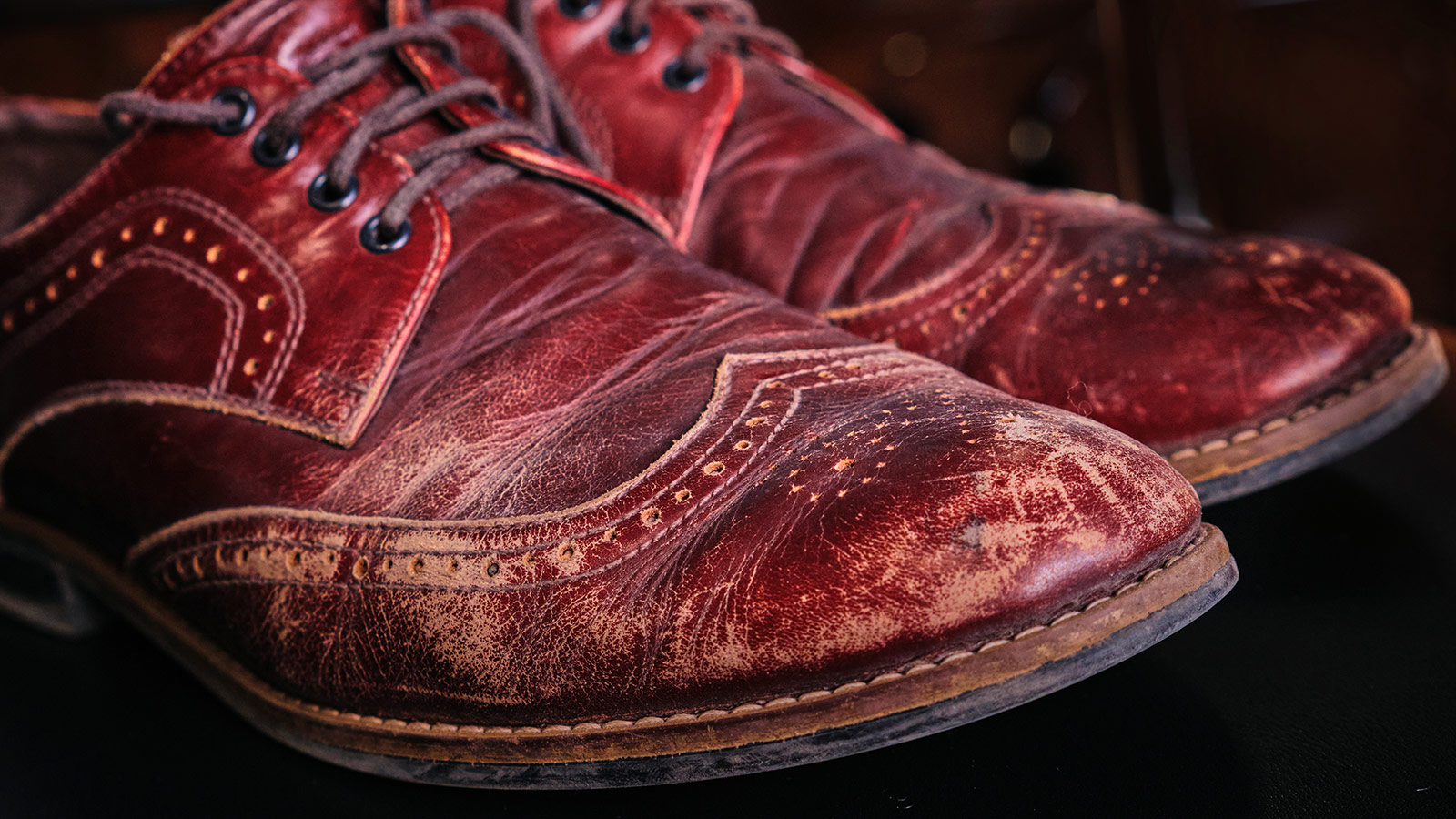

FAQs
Why Do Guys Have Skid Marks In Underwear
Modified: August 4, 2023
Discover the reasons behind skid marks in underwear with this comprehensive guide. Get answers to your general questions and learn how to prevent them.
(Many of the links in this article redirect to a specific reviewed product. Your purchase of these products through affiliate links helps to generate commission for Under-tec.com, at no extra cost. Learn more)
Table of Contents
- Introduction
- Understanding skid marks in underwear
- Causes of skid marks
- Poor hygiene practices
- Inadequate wiping technique
- Diet and digestion issues
- Sweating and moisture
- Improper underwear choice
- Tips for preventing skid marks
- Proper hygiene routine
- Effective wiping techniques
- Dietary adjustments
- Using appropriate undergarments
- Conclusion
Introduction
Skid marks in underwear are an uncomfortable and embarrassing issue that many individuals, particularly men, experience. These unsightly stains can be a source of frustration and anxiety, leading to questions about their causes and how to prevent them. But rest assured, you are not alone in dealing with this common problem.
Understanding why skid marks occur in underwear is the first step towards finding effective solutions. These marks typically result from remnants of fecal matter or sweat that have not been adequately cleaned during the toileting process. While it may seem like a trivial matter, skid marks can have a negative impact on your confidence and overall well-being.
In this article, we will delve into the various factors that contribute to the formation of skid marks in underwear. From poor hygiene practices to inadequate wiping techniques, sweat, and even dietary issues, we’ll explore each aspect to gain a comprehensive understanding of the problem.
Additionally, we will provide practical tips on how to prevent skid marks from occurring. By implementing proper hygiene routines, adopting effective wiping techniques, making dietary adjustments, and choosing the right undergarments, you can minimize the occurrence of skid marks and regain your confidence.
So, if you’ve ever wondered why skid marks happen or how you can prevent them, keep reading. This article will equip you with the knowledge and strategies you need to overcome this common issue and ensure your underwear remains stain-free.
Understanding skid marks in underwear
Before we delve into the causes and prevention of skid marks, it’s essential to understand exactly what they are. Skid marks refer to the stains and residue left behind in underwear, usually in the rear area, after bowel movements.
These marks are the result of inadequate cleaning or incomplete removal of fecal matter during the wiping process. When residue remains on the skin, it transfers to the underwear, creating unsightly stains.
Skid marks can also be caused by the presence of sweat and moisture in the anal area. The combination of sweat and fecal matter can create a sticky residue that clings to the fabric of your underwear.
It’s important to note that skid marks are not just a hygiene issue; they can also be a sign of underlying health issues. Digestive problems, such as irritable bowel syndrome (IBS) or excessive gas, can contribute to the frequency and severity of skid marks.
Now that we have a clear understanding of what skid marks are, let’s explore the various factors that can contribute to their occurrence. By identifying the root causes, we can take steps to prevent and minimize their presence, leading to improved hygiene and peace of mind.
Causes of skid marks
Skid marks in underwear can be attributed to several factors, ranging from poor hygiene practices to dietary issues. Understanding these causes is essential in order to address and prevent the occurrence of skid marks effectively. Let’s explore the key factors behind this common problem:
- Poor hygiene practices: Inadequate cleaning after a bowel movement is one of the primary causes of skid marks. Rushing through the wiping process or not paying enough attention can leave behind residue on the skin, which then transfers to the underwear.
- Inadequate wiping technique: The way you wipe after using the toilet can also contribute to the formation of skid marks. Wiping back-to-front or using rough toilet paper can cause smearing rather than thorough cleaning, leading to residue in the underwear.
- Diet and digestion issues: Your diet plays a significant role in your bowel movements and overall digestion. A diet lacking in fiber, fruits, and vegetables can lead to constipation or irregular bowel movements, increasing the likelihood of skid marks. Some individuals may also have specific food intolerances that can cause digestive issues, resulting in skid marks.
- Sweating and moisture: Excessive sweating in the anal area can create a moist environment, which can exacerbate the formation of skid marks. Sweat, combined with residual fecal matter, can create a sticky residue that adheres to the fabric of your underwear.
- Improper underwear choice: The type of underwear you choose can also impact the occurrence of skid marks. Tight-fitting or non-breathable fabrics can trap moisture, increasing the chances of staining. It is advisable to opt for underwear made from breathable materials, such as cotton, that can help keep the anal area dry and minimize the risk of skid marks.
By understanding these causes, you can take proactive steps to address them and reduce the likelihood of skid marks in your underwear. In the following sections, we will delve into practical tips and strategies for preventing skid marks, ranging from improving your hygiene routine to making dietary adjustments and choosing suitable undergarments. So, let’s explore these solutions and ensure your underwear remains free from unsightly stains.
Poor hygiene practices
Poor hygiene practices are one of the primary causes of skid marks in underwear. When it comes to maintaining cleanliness in the anal area, proper hygiene is crucial to prevent the transfer of fecal matter to your underwear. Here are some common poor hygiene practices that can contribute to skid marks:
- Rushing through the wiping process: Many people are in a hurry when using the toilet, which can lead to insufficient cleaning. Taking the time to thoroughly wipe after a bowel movement is essential to ensure that no residue is left behind on the skin.
- Insufficient wiping: Some individuals may not wipe enough times or may not use enough toilet paper to effectively remove all traces of fecal matter. Inadequate wiping can result in smearing rather than thorough cleaning, leading to skid marks in underwear.
- Using harsh or rough toilet paper: Rough or low-quality toilet paper can be abrasive on the skin, making it difficult to clean effectively. This can leave behind residue that subsequently transfers to your underwear.
- Ignoring proper cleaning technique: It’s important to follow the correct wiping motion—front-to-back for women and back-to-front for men—to minimize the risk of transferring bacteria from the anal area to the urethra or vaginal area (in the case of women). Following the appropriate technique can help maintain good hygiene and reduce skid marks.
To address poor hygiene practices and reduce the occurrence of skid marks, there are several steps you can take:
- Take your time: Allow yourself enough time on the toilet to ensure thorough cleaning after each bowel movement.
- Use gentle wipes or toilet paper: Look for soft, high-quality toilet paper or consider using wet wipes specifically designed for intimate hygiene. These can be more effective in cleaning without causing irritation.
- Be mindful of wiping technique: Follow the appropriate wiping motion, ensuring the front-to-back or back-to-front motion, depending on your gender, to maintain proper hygiene and prevent the spread of bacteria.
- Consider using a bidet or handheld sprayer: Installing a bidet attachment or using a handheld sprayer can provide a more thorough cleaning experience, reducing the chances of skid marks.
- Practice good hand hygiene: After toileting, always wash your hands with soap and water to minimize the risk of spreading bacteria.
By adopting these practices and being mindful of your hygiene routine, you can significantly reduce the occurrence of skid marks and maintain a clean and fresh feeling throughout the day.
Inadequate wiping technique
Inadequate wiping technique is another significant factor that contributes to the formation of skid marks in underwear. When proper wiping techniques are not followed, residue from bowel movements may not be adequately removed, leading to unsightly stains. Here are some common issues related to inadequate wiping technique:
- Insufficient wipes: Many individuals do not wipe enough times to ensure thorough cleaning. One or two wipes may not be enough to remove all traces of fecal matter, resulting in residue transferring to the underwear.
- Use of dry and rough toilet paper: Dry and rough toilet paper can be abrasive on the skin, making it difficult to clean effectively. It can also cause irritation and discomfort. Using higher quality, softer toilet paper can help in achieving better cleanliness.
- Incorrect wiping motion: The wiping motion you use can impact the effectiveness of cleaning. It is important to wipe in the proper direction to minimize the risk of spreading bacteria from the anal area to other body parts. For men, wiping from back-to-front is recommended, while for women, wiping from front-to-back is advised.
- Applying too much pressure: Applying excessive pressure while wiping can cause smearing instead of proper cleaning. It is important to use a gentle wiping motion to avoid pushing residue into the skin or fabric.
- Using the wrong hand: Using the non-dominant hand for wiping can make it challenging to achieve thorough cleanliness. Utilizing your dominant hand ensures better control and accuracy during the wiping process.
To improve your wiping technique and reduce the occurrence of skid marks, consider the following tips:
- Wipe thoroughly: Take the time to wipe multiple times to ensure complete cleaning. Avoid rushing the process to avoid leaving behind residue.
- Use quality toilet paper: Opt for softer and higher-quality toilet paper to minimize skin irritation and improve cleaning efficiency.
- Follow the appropriate wiping motion: For men, wipe from back-to-front, and for women, wipe from front-to-back. This helps prevent the spread of bacteria.
- Apply gentle pressure: Use a gentle wiping motion to avoid smearing and ensure effective cleaning.
- Develop consistency: Stick to using your dominant hand for wiping to enhance control and accuracy.
By adopting these techniques during your bathroom routine, you can effectively clean the anal area and minimize the likelihood of skid marks in your underwear. Remember, proper wiping technique is crucial for maintaining good hygiene and minimizing the risk of discomfort and stains.
Diet and digestion issues
Your diet plays a significant role in your bowel movements and overall digestion, which in turn can affect the occurrence of skid marks in underwear. Certain dietary habits and digestion issues can contribute to irregular bowel movements and an increased likelihood of staining. Here are some factors related to diet and digestion that can influence skid marks:
- Lack of fiber: A diet low in fiber can lead to constipation and hard stools, making them difficult to pass and clean thoroughly. This can result in residue lingering in the anal area and transferring to your underwear.
- Insufficient hydration: Not drinking enough water can lead to dehydration, which can cause hard and dry stools. Adequate hydration is essential for maintaining regular bowel movements and ensuring the proper elimination of waste.
- Excessive consumption of processed foods: Processed foods are often high in fat, salt, and preservatives, which can disrupt normal digestion and lead to irregular bowel movements. These foods may also lack the necessary nutrients and fiber for healthy digestion.
- Food intolerances and sensitivities: Some individuals may have specific food intolerances or sensitivities that can cause digestive issues. These issues can result in irregular bowel movements and an increased risk of skid marks.
To address diet and digestion-related causes of skid marks, consider the following tips:
- Increase fiber intake: Incorporate fiber-rich foods into your diet, such as fruits, vegetables, whole grains, and legumes. Fiber adds bulk to your stools and promotes regular bowel movements, reducing the chances of residue and staining.
- Stay hydrated: Drink an adequate amount of water throughout the day to maintain hydration levels and support healthy digestion. Aim for at least eight glasses of water per day.
- Avoid excessive processed foods: Limit your consumption of processed foods that can disrupt digestion. Opt for whole, unprocessed foods that are nutrient-rich and easier to digest.
- Identify food intolerances/sensitivities: If you suspect certain foods are causing digestive issues, consider keeping a food diary and consulting with a healthcare professional or nutritionist to identify any food intolerances or sensitivities.
Making these dietary adjustments can help improve your digestion and regularity, minimizing the occurrence of skid marks in your underwear. Remember, a well-balanced diet and proper hydration are key factors in maintaining a healthy digestive system and reducing the risk of staining.
Sweating and moisture
Sweating and moisture in the anal area can contribute to the formation of skid marks in underwear. Excessive sweating and the presence of moisture create a favorable environment for the combination of sweat and residual fecal matter, leading to sticky residue that adheres to the fabric. Here are a few factors related to sweating and moisture that can contribute to skid marks:
- Hot and humid environments: Living or working in hot and humid climates can lead to increased sweating, especially in the anal area. The moisture from sweating, coupled with any residual fecal matter, can result in the formation of skid marks.
- Physical activity: Engaging in physical activities, such as exercise or sports, can induce sweating, including in the anal region. The combination of sweat and any remaining fecal matter can create a sticky residue that stains underwear.
- Poor ventilation: Wearing tight-fitting or non-breathable underwear can hinder proper airflow and ventilation, trapping moisture against the skin. This can contribute to increased sweating and moisture, potentially leading to skid marks.
To address the issue of sweating and moisture and minimize the occurrence of skid marks, consider the following tips:
- Choose breathable underwear: Opt for underwear made from breathable materials, such as cotton, which allow air to circulate and moisture to evaporate, keeping the anal area drier.
- Wear moisture-wicking fabrics during physical activities: When engaging in physical activities, wear moisture-wicking fabrics that draw sweat away from the body, reducing the chances of moisture accumulation.
- Keep the anal area clean and dry: Ensure the anal area is thoroughly cleaned and dried after each bowel movement. This can help minimize the risk of moisture contributing to skid marks.
- Avoid tight-fitting clothing: Choose looser-fitting clothing, particularly in the anal area, as this allows for better airflow and ventilation, reducing the likelihood of sweating and moisture accumulation.
- Consider using talcum powder or antiperspirant: Applying talcum powder or antiperspirant to the anal area can help absorb excess moisture and reduce sweating.
By implementing these suggestions, you can create a drier environment in the anal area, minimizing sweat and moisture, and thereby reducing the likelihood of skid marks in your underwear. Remember, maintaining proper ventilation and keeping the anal area clean and dry are key in addressing the issue of sweating and moisture.
Improper underwear choice
The choice of underwear can significantly impact the occurrence of skid marks. Wearing improper or ill-fitting underwear can contribute to increased sweating, moisture retention, and a higher probability of skid marks. Here are some aspects related to underwear choice that can influence the occurrence of skid marks:
- Tight-fitting underwear: Wearing tight-fitting underwear can restrict airflow and ventilation, leading to increased sweating and moisture in the anal area. This moisture, combined with residual fecal matter, can result in skid marks.
- Non-absorbent materials: Underwear made from non-absorbent materials, such as synthetic fabrics, can trap moisture against the skin, creating an environment conducive to skid marks. It is advisable to opt for underwear made from breathable materials like cotton that can absorb moisture effectively.
- Non-breathable underwear: Some underwear styles, such as thongs or certain synthetic fabrics, may not allow proper airflow and ventilation. This can lead to increased sweating and moisture retention, contributing to skid marks.
To address the issue of improper underwear choice and minimize the occurrence of skid marks, consider the following tips:
- Choose breathable fabrics: Opt for underwear made from natural, breathable fabrics like cotton that allow for better airflow and moisture absorption.
- Ensure a proper fit: Wearing underwear that is too tight can contribute to sweating and moisture retention. Ensure that your underwear provides a comfortable fit without being overly restrictive.
- Avoid non-absorbent materials: Stay away from synthetic fabrics that don’t allow proper moisture absorption. Instead, choose underwear made from materials that effectively wick moisture away from the body.
- Wear proper styles: Different underwear styles suit different individuals, so choose styles that provide adequate coverage and comfort while allowing for proper ventilation.
- Change underwear regularly: Regularly changing your underwear ensures that you have a fresh and clean environment, reducing the chances of skid marks caused by residual moisture.
By following these guidelines and selecting appropriate underwear, you can minimize sweating, moisture retention, and ultimately, the occurrence of skid marks. Remember, proper airflow, moisture absorption, and a comfortable fit are key factors in preventing skid marks resulting from improper underwear choice.
Tips for preventing skid marks
Now that we have explored the various causes of skid marks in underwear, it’s time to discuss practical tips for preventing their occurrence. By implementing these strategies, you can maintain better hygiene, minimize sweating and moisture, and reduce the risk of skid marks. Here are some useful tips:
- Establish a proper hygiene routine: Develop a consistent hygiene routine that includes thorough cleaning after each bowel movement. Take your time and ensure that you clean the anal area effectively.
- Use effective wiping techniques: Follow the appropriate wiping motion, whether it’s back-to-front or front-to-back, depending on your gender. Use soft toilet paper or wet wipes for gentle and thorough cleaning.
- Improve your diet: Incorporate fiber-rich foods into your meals, such as fruits, vegetables, whole grains, and legumes. Stay hydrated by drinking enough water to maintain regular bowel movements.
- Choose breathable underwear: Opt for underwear made from breathable materials, like cotton, that allow for proper ventilation and moisture absorption. Avoid tight-fitting or non-breathable fabrics that can trap sweat and moisture.
- Stay fresh during physical activities: If you engage in physical activities that cause sweating, consider changing into fresh underwear afterward to maintain cleanliness and prevent the build-up of moisture.
- Consider using a bidet or wet wipes: Incorporate a bidet attachment or use wet wipes specifically designed for intimate hygiene to ensure thorough cleaning and minimize the risk of skid marks.
- Practice good hand hygiene: Always wash your hands thoroughly with soap and water after using the toilet to minimize the spread of bacteria.
By following these tips consistently, you can significantly reduce the occurrence of skid marks in your underwear and maintain better overall hygiene. Remember, prevention is key, and adopting these habits will not only help you feel cleaner and more confident but also contribute to good overall health.
Proper hygiene routine
A proper hygiene routine is crucial for preventing skid marks and maintaining overall cleanliness in the anal area. By incorporating these practices into your daily routine, you can effectively minimize the risk of skid marks in your underwear. Here are some essential steps for a proper hygiene routine:
- Thoroughly clean the anal area: After each bowel movement, take the time to clean the anal area thoroughly. Use gentle, unscented soap and warm water to wash the area, ensuring that all residue is removed.
- Use a bidet or wet wipes: Consider using a bidet attachment or wet wipes specifically designed for intimate hygiene. These can provide a thorough cleaning experience and help eliminate any remaining residue.
- Pat dry: After cleaning, pat the anal area dry with a clean, soft towel or toilet paper. Avoid harsh rubbing, as this can cause irritation or microtears on the skin.
- Change underwear regularly: Ensure that you change your underwear regularly, especially after physical activities or when you feel sweaty. Fresh underwear reduces the chances of skid marks caused by residual moisture or bacteria.
- Wash your hands: Always wash your hands with soap and water after using the toilet to minimize the spread of bacteria. This step is important for maintaining overall hygiene.
In addition to these steps, here are some additional tips to enhance your hygiene routine:
- Trim anal hair: If you have excessive anal hair, consider trimming it to maintain cleanliness and reduce the likelihood of bacteria and fecal matter clinging to the hair.
- Use talcum powder: Applying talcum powder to the anal area can help absorb excess moisture, keeping the area dry and minimizing the risk of skid marks.
- Avoid harsh soaps or scented products: Harsh soaps and scented products can irritate the skin in the anal area. Opt for gentle, unscented products to reduce the risk of irritation and discomfort.
- Visit a healthcare professional if necessary: If you experience persistent issues or discomfort in the anal area, it is advisable to consult with a healthcare professional who can provide guidance and treatment if needed.
By implementing a proper hygiene routine and following these tips consistently, you can significantly reduce the occurrence of skid marks. Remember, cleanliness in the anal area is essential not only for preventing skid marks but also for overall hygiene and well-being.
Effective wiping techniques
Proper wiping techniques are crucial in ensuring thorough cleaning and minimizing the risk of skid marks. By following these techniques, you can effectively remove residual fecal matter and maintain better hygiene in the anal area. Here are some effective wiping techniques to consider:
- Use gentle wiping motions: When wiping, use gentle and controlled motions to avoid smearing or pushing residue into the skin. It is important not to apply excessive pressure, as this can lead to ineffective cleaning.
- Wipe from front-to-back (for women) or back-to-front (for men): The wiping direction differs based on gender. Women should wipe from front-to-back, away from the urethra and vaginal area, to reduce the risk of spreading bacteria. Men should wipe from back-to-front to ensure thorough cleaning.
- Use adequate toilet paper: Ensure that you have enough toilet paper to wipe effectively. Folding the toilet paper can provide a larger surface area for cleaning, allowing you to wipe multiple times without smearing.
- Consider using wet wipes: Wet wipes specifically designed for intimate hygiene can provide a more thorough cleaning experience. They offer moistness and freshness, reducing the chances of residue remaining on the skin.
- Follow up with a dry wipe: After using wet wipes, consider using a dry toilet paper or a towel to ensure the anal area is completely dry. Moisture retention can contribute to the formation of skid marks.
Here are some additional tips to enhance your wiping technique:
- Practice consistency: Develop a routine and be consistent with your wiping technique. This ensures thoroughness and minimizes the risk of missing areas.
- Take your time: Rushing through the wiping process can lead to inadequate cleaning. Allow yourself enough time on the toilet to ensure that you clean every area thoroughly.
- Upgrade your toilet paper: Consider using a softer and higher-quality toilet paper that is gentle on the skin and provides better cleaning efficiency.
- Consider a bidet or handheld sprayer: Installing a bidet attachment or using a handheld sprayer can provide a more effective and comfortable cleaning experience, reducing the chances of skid marks.
- Practice good hand hygiene: Always wash your hands with soap and water after wiping to minimize the spread of bacteria.
By implementing these effective wiping techniques and following the additional tips, you can ensure more thorough cleanliness in the anal area and significantly reduce the occurrence of skid marks. Remember, consistent and proper cleaning techniques are essential for maintaining good hygiene and minimizing the risk of unsightly stains.
Dietary adjustments
Making necessary dietary adjustments can play a significant role in preventing skid marks. Your diet affects your bowel movements, digestion, and overall gastrointestinal health, all of which can impact the occurrence of skid marks. Here are some dietary adjustments you can consider to minimize the risk of skid marks:
- Increase fiber intake: Incorporating fiber-rich foods into your diet can promote regular bowel movements and reduce the risk of constipation. Include fruits, vegetables, whole grains, legumes, and nuts in your daily meals.
- Stay hydrated: Drinking an adequate amount of water throughout the day helps maintain hydration and supports healthy digestion. Aim to drink at least eight glasses of water daily.
- Avoid excessive processed foods: Processed foods, such as fast food, sugary snacks, and processed meats, are often low in fiber and nutrients. These foods can disrupt digestion and lead to irregular bowel movements. Opt for whole and unprocessed foods instead.
- Identify food intolerances/sensitivities: Some individuals may have specific food intolerances or sensitivities that can cause digestive issues and irregular bowel movements. Keeping a food diary or seeking professional guidance can help identify any problematic foods.
- Consider probiotics: Probiotics can promote a healthy gut by improving digestion and regulating bowel movements. Consult with a healthcare professional to determine if adding probiotics to your diet may be beneficial.
- Eat smaller, more frequent meals: Consuming smaller, more frequent meals throughout the day rather than large, heavy meals can support better digestion and prevent digestive issues that can contribute to skid marks.
It’s important to note that dietary adjustments may vary for each individual based on their specific needs and any underlying health conditions. Consulting with a healthcare professional or a registered dietitian can provide personalized guidance and recommendations.
By incorporating these dietary adjustments, you can promote healthier digestion, regular bowel movements, and a reduced risk of skid marks. Remember, a well-balanced and fiber-rich diet, coupled with proper hydration, is key to maintaining good gastrointestinal health and preventing staining in your underwear.
Using appropriate undergarments
The choice of undergarments can greatly influence the occurrence of skid marks in your underwear. Selecting appropriate undergarments is essential for maintaining proper ventilation, minimizing moisture retention, and reducing the risk of skid marks. Here are some factors to consider when choosing undergarments:
- Opt for breathable fabrics: Choose undergarments made from breathable materials, such as cotton, that allow air to circulate and moisture to evaporate. Breathable fabrics help keep the anal area dry and reduce the likelihood of skid marks.
- Ensure a proper fit: Wearing undergarments that are too tight can restrict airflow and lead to increased sweating and moisture retention. Make sure your undergarments fit comfortably without being overly constrictive.
- Avoid non-absorbent materials: Undergarments made from non-absorbent materials, such as certain synthetic fabrics, can trap moisture against the skin. This creates an environment conducive to skid marks. Opt for undergarments that effectively absorb moisture instead.
- Select appropriate styles: Different undergarment styles suit different individuals. Choose styles that provide adequate coverage and comfort while allowing for proper ventilation. Avoid styles that are too tight or offer non-breathable materials.
- Change underwear regularly: Regularly changing your underwear, especially after physical activities or when you feel sweaty, can help maintain cleanliness and reduce the build-up of moisture. Fresh underwear decreases the chances of skid marks caused by residual moisture or bacteria.
Here are some additional tips to consider for using appropriate undergarments:
- Avoid fabric softeners and harsh detergents: Fabric softeners and harsh detergents can leave residue on your undergarments, potentially contributing to skid marks. Opt for mild, fragrance-free detergents and avoid using fabric softeners.
- Consider using absorbent pads: For individuals who experience excessive sweating or have specific health conditions, using absorbent pads or liners can help manage moisture and reduce the risk of skid marks.
- Consider moisture-wicking underwear: Moisture-wicking underwear made from specialized fabrics can help draw sweat away from the body, keeping the anal area drier and minimizing the chances of skid marks.
- Follow proper care instructions: Read and follow the care instructions for your undergarments to ensure their longevity and optimal performance. Proper care helps maintain their absorbency and effectiveness.
By selecting appropriate undergarments and following these tips, you can ensure better ventilation, moisture control, and reduced risk of skid marks in your underwear. Remember, choosing the right undergarments is crucial for maintaining comfort, freshness, and overall hygiene.
Conclusion
Skid marks in underwear can be an embarrassing and bothersome issue for many individuals, but with proper understanding and proactive measures, they can be effectively prevented. By addressing the underlying causes and implementing practical strategies, you can maintain better hygiene and minimize the occurrence of skid marks.
Understanding skid marks and their causes, such as poor hygiene practices, inadequate wiping techniques, diet and digestion issues, sweating and moisture, and improper underwear choice, allows you to tackle the problem at its root. By adopting a proper hygiene routine, practicing effective wiping techniques, making dietary adjustments, and choosing appropriate undergarments, you can significantly reduce the chances of skid marks.
Remember to take your time during toileting, use gentle wiping motions, follow the appropriate wiping direction, and consider using wet wipes or bidets for thorough cleaning. Adjusting your diet to include more fiber-rich foods, staying hydrated, and avoiding excessive processed foods can improve digestion and promote regular bowel movements. Additionally, choosing breathable fabrics, ensuring a proper fit, and changing underwear regularly help maintain cleanliness and minimize moisture retention.
It’s essential to prioritize your hygiene and take the necessary steps to prevent skid marks. However, if you continue to experience persistent issues or discomfort, it is recommended to consult with a healthcare professional for further evaluation and guidance.
By incorporating these tips into your daily routine and being proactive in maintaining proper hygiene, you can regain your confidence and enjoy a stain-free underwear experience. Remember, prevention is key, and with consistent efforts, you can effectively minimize skid marks and ensure a clean and fresh feeling throughout the day.










